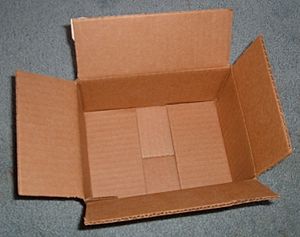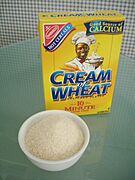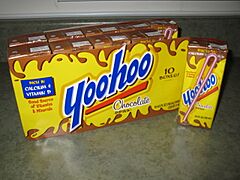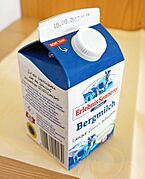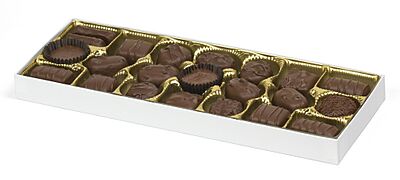Cardboard box facts for kids
Cardboard boxes are special containers made in factories. They are mostly used for packaging and moving goods. When people in the industry talk about these boxes, they often avoid the word "cardboard." This is because "cardboard" can mean many different strong paper materials. These include thick paper like card stock, wavy corrugated fiberboard, and flat paperboard. A great thing about cardboard boxes is that they are easy to recycle!
Contents
What are Cardboard Boxes?
Many types of containers are often called "cardboard boxes." But in business and factories, people use more specific names. This helps everyone know exactly what material they are talking about. The word "cardboard" is often avoided because it doesn't describe one specific material.
Here are some common paper-based materials used for packaging:
- Paper is a thin material. We mostly use it for writing, printing, or wrapping things. It's made by pressing wet fibers, usually from wood, into flat sheets.
- Paperboard is thicker than regular paper. It's usually more than 0.25 millimeters thick. It can be a single layer or many layers pressed together.
- Corrugated fiberboard is also called corrugated board. It's a strong material made of a wavy middle layer. This wavy part is glued between one or two flat outer layers. The wavy part gives corrugated boxes their strength. This is why they are often used for shipping and storage.
There are also many names for the containers themselves:
- A shipping container made of corrugated fiberboard is often called a "cardboard box." It can also be called a "carton" or a "case."
- A folding carton made of paperboard is sometimes called a "cardboard box." Think of a cereal box!
- A set-up box is made from paperboard that doesn't bend easily. This is also sometimes called a "cardboard box."
- Drink boxes are made of special layered paperboard. People might call them "cardboard boxes" or "cartons."
Types of Cardboard Boxes
Here are some examples of containers that people often call "cardboard boxes":
History of Cardboard Boxes
The first commercial paperboard box was made in England in 1817. Cardboard box packaging also started in Germany that same year.
The Invention of Pre-Cut Boxes
In 1890, a Scottish-born inventor named Robert Gair created the pre-cut cardboard box. These were flat pieces made in large amounts that could be folded into boxes. Gair's idea came from an accident. He was a printer in Brooklyn in the 1870s. One day, while printing seed bags, a metal ruler accidentally cut them instead of just creasing them. Gair realized that cutting and creasing in one step could make ready-to-fold boxes. This idea was later used for corrugated boxboard when that material became available.
Early Uses of Cardboard Boxes
Cardboard boxes were first used in France around 1840. They helped silk makers transport Bombyx mori moths and their eggs. For over a century, making cardboard boxes was a big business in the Valréas area of France.
The rise of lightweight flaked cereals also made cardboard boxes more popular. The Kellogg Company was one of the first to use cardboard boxes for cereal.
The Rise of Corrugated Cardboard
Wavy, or "pleated," paper was first patented in England in 1856. It was used as a lining for tall hats. But corrugated boxboard was not patented for shipping until 1871. Albert Jones of New York City received the patent for single-sided corrugated board. He used it to wrap bottles and glass lantern chimneys.
In 1874, the first machine to make large amounts of corrugated board was built. That same year, Oliver Long improved Jones's design. He invented corrugated board with flat layers on both sides. This is the corrugated cardboard we use today!
The first corrugated cardboard box made in the US was in 1895. By the early 1900s, corrugated paper shipping cartons began to replace wooden crates and boxes.
Fun with Cardboard Boxes
Cardboard and other paper materials can have a second life! They are cheap and great for many projects. You can use them for science experiments, children's toys, costumes, or even for insulation. Many kids love playing inside boxes.
There's a common saying that if you give a child a big, expensive toy, they might get bored with it. Instead, they will play with the box! While this is often a joke, kids really do enjoy playing with boxes. They use their imagination to turn a box into anything they can dream of. For example, in the comic strip Calvin and Hobbes, the main character, Calvin, often imagined a cardboard box as a "transmogrifier," a "duplicator," or a time machine.
The cardboard box is so well-known as a plaything that it was added to the National Toy Hall of Fame in the US in 2005. It's one of the few toys not linked to a specific brand to get this honor. As a result, a toy "house" made from a large cardboard box was added to the Hall. You can see it at the Strong National Museum of Play in Rochester, New York.
In the Metal Gear series of stealth video games, there's a funny running joke. Players can use a cardboard box as an item in the game. They can hide inside it to sneak past enemies without being seen!
Cardboard for Housing and Furniture
Living in a cardboard box is often linked to homelessness. However, in 2005, an architect named Peter Ryan designed a house mostly made of cardboard in Melbourne.
More commonly, you can find small seats or tables made from corrugated cardboard. Stores also often use cardboard displays to show their products.
Cardboard for Cushioning
Cardboard boxes can absorb energy when something hits them. This is because of the air trapped inside and the box's limited stiffness. In 2012, British stuntman Gary Connery landed safely without a parachute. He used a special landing zone made of thousands of cardboard boxes. This "runway" was about 3.6 meters (12 feet) high and helped cushion his fall.
See also
- Banana box, a type of cardboard box for bananas
- Eurocontainer, a system for reusable transport boxes
- The Adventure of the Cardboard Box, a Sherlock Holmes story


